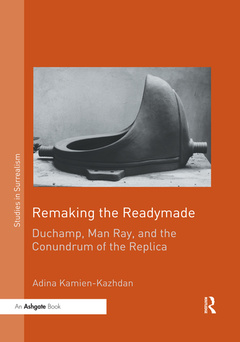Remaking the Readymade Duchamp, Man Ray, and the Conundrum of the Replica Studies in Surrealism Series
Auteur : Kamien-Kazhdan Adina

Replication and originality are central concepts in the artistic oeuvres of Marcel Duchamp and Man Ray. Remaking the Readymade reveals the underlying and previously unexplored processes and rationales for the collaboration between Duchamp, Man Ray, and Arturo Schwarz on the replication of readymades and objects.
The 1964 editioned replicas of the readymades sent shock waves through the art world. Even though the replicas undermined ideas of authorship and problematized the notion of identity and the artist, they paradoxically shared in the aura of the originals, becoming stand-ins for the readymades. Scholar-poet-dealer Arturo Schwarz played a crucial role, opening the door to joint or alternate authorship?an outstanding relationship between artist and dealer. By unearthing previously unpublished correspondence and documentary materials and combining this material with newly conducted exclusive interviews with key participants, Remaking the Readymade details heretofore unrevealed aspects of the technical processes involved in the (re)creation of iconic, long-lost Dada objects.
Launched on the heels of the centenary of Duchamp?s Fountain, this new analysis intensifies and complicates our understanding of Duchamp and Man Ray? initial conceptions, and raises questions about replication and authorship that will stimulate significant debate about the legacy of the artists, the continuing significance of their works, and the meaning of terms such as creativity, originality, and value in the formation of art.
Table of Contents
List of Illustrations Acknowledgements Introduction
PART I Replication in the 20th Century and the Galleria Schwarz
Chapter 1 Replication: Motivations, Terms, and Issues
Replication: Terms and Definitions
Replication: Why and When?
Multiples of the 1950s and 1960s: New Initiatives of Artists and Dealers
The Replica's Aura: Legal and Theoretical Questions
Chapter 2 Galleria Schwarz
Arturo Schwarz: From Alexandria to Milan
The Libreria-Galleria Schwarz
Views on Dada and Surrealism
Schwarz, Breton, and Trotsky
Judaism, Kabbalah, and Alchemy
Collection and Donation
PART II Replication in the Oeuvre of Duchamp and Man Ray
Chapter 3 Duchamp: "Not an Original in the Conventional Sense"
Duchamp and the Readymade
Duchamp and Replication
Duchamp Replicators 1950-1966
Chapter 4 Man Ray: Objects to Multiples
Multiform Man Ray
Exhibitions and Reputation
"Objects of My Affection"
Duchamp-Man Ray Creative Exchange
Replication of Man Ray’s Objects Pre-Schwarz
PART II Commissioning and Making of the Editioned Replicas
Chapter 5 Mirrorical Return: Marcel Duchamp's Editioned Readymades
Arturo Schwarz: The Complete Works of Marcel DuchampInitial Joint Projects: The Erotic Objects
Exhibitions at Galleria Schwarz and Commissioning of Replicas
Replication Process
Case by Case Analysis of the 1964-65 Editions
Chapter 6 The "Indestructible" Man Ray
Man Ray and Schwarz: The Rigour of ImaginationExhibitions at Galleria Schwarz and Commissioning of Replicas
Replication Process: Case by CaseOther Editors of Man Ray’s Objects
Chapter 7 Reception of the Editioned Replicas
Duchamp: The Value of the Readymade and its Replicas
Critical Reception of the 1964 Editions
Impact on Artists and Scholarship
Art Market History and Museum Purchasing Policies
Conclusion
Bibliography
I Unpublished Correspondence
II Interviews
III General
IV Publications by Arturo Schwarz
AppendixA Marcel Duchamp – original to replica tables
B Man Ray – original to replica tables
Adina Kamien-Kazhdan, PhD, is David Rockefeller Senior Curator, The Stella Fischbach Department of Modern Art at The Israel Museum, Jerusalem.
Date de parution : 07-2020
17.4x24.6 cm
Date de parution : 05-2018
17.4x24.6 cm
Thèmes de Remaking the Readymade :
Mots-clés :
Man Ray; surrealism; Moderna Museet; art history; Man Ray’s Work; twentieth century; Duchamp’s Readymades; Marcel Duchamp; Unique Replica; replication; Emak Bakia; innovation; Original Readymades; aura; Duchamp’s Work; authorship; value; Museum Boijmans Van Beuningen; creativity; Moderna Museet Stockholm; originality; Philadelphia Museum; uniqueness; Daniel Spoerri; Arturo Schwarz; Indestructible Object; Galeria Schwarz; Walter Arensberg Collection; Dada; Fresh Widow; avant garde; Marcel Duchamp’s Readymades; modern art; Israel Museum; multiples; Duchamp Exhibition; original; Bicycle Wheel; Pasadena Art Museum; art market; Hat Rack; editions; RMN Grand Palais; Standard Stoppages; Bottle Rack



